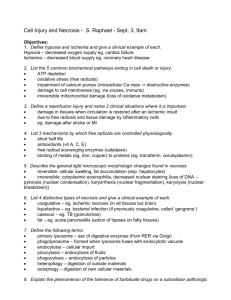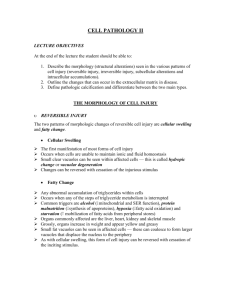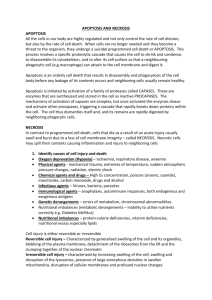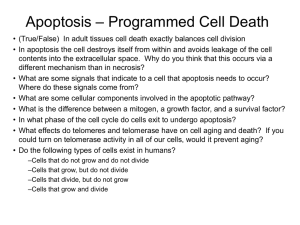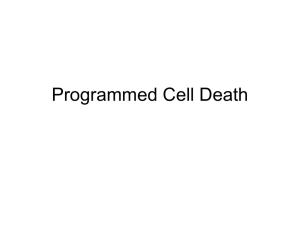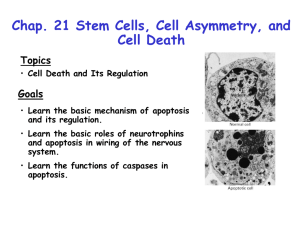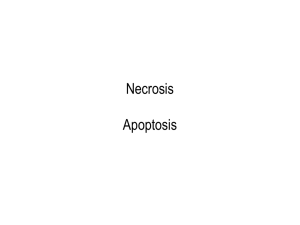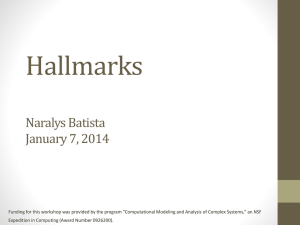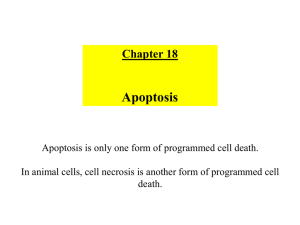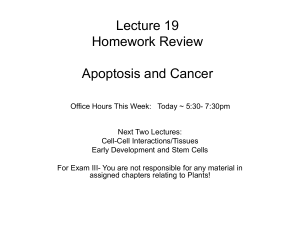Apoptosis
advertisement
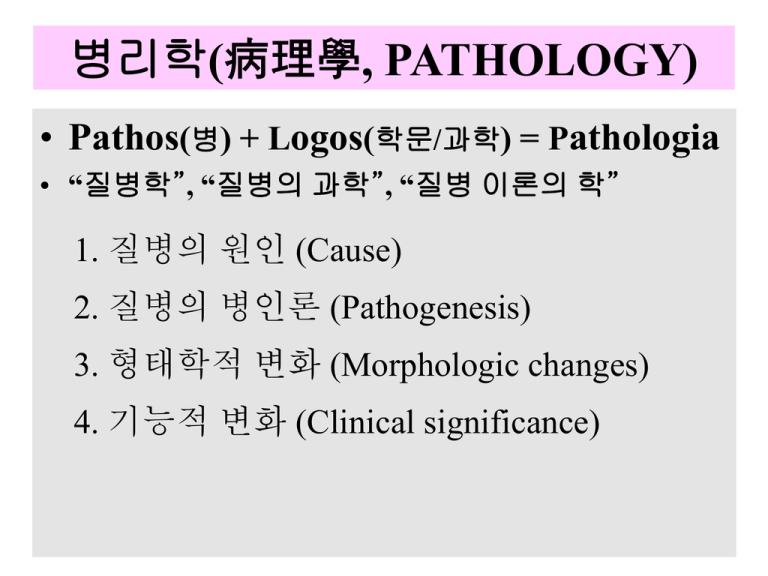
병리학(病理學, PATHOLOGY) • Pathos(병) + Logos(학문/과학) = Pathologia • “질병학”, “질병의 과학”, “질병 이론의 학” 1. 질병의 원인 (Cause) 2. 질병의 병인론 (Pathogenesis) 3. 형태학적 변화 (Morphologic changes) 4. 기능적 변화 (Clinical significance) 1. 세포손상의 원인 1. 저산소증: 허혈, 심폐기능 부전, 빈혈, CO 중독 등 2. 물리적 요인: 기계적외상, 온열손상, 기압변동, 방사선, 전기 쇽 3. 화학물질과 약물: 산소, 비소, 시안화물, 수은염, 환경 및 대기오염 물 질, 일산화탄소, 석면, 규소, 술, 담배 4. 감염성 요인: 바이러스, 리케치아, 세균, 진균, 기생충 등 5. 면역 또는 염증반응: 혈구 (호중구, 림프구, 대식세포), 화학적 인자 (항체, 보체, lymphokines) 6. 유전장애: 선천성, 후천성, iatrogenic 7. 영양불균형: 영양실조, 영양과잉 8. Aging 2. 세포반응의 형태 1. 恒常性(Homeostasis): 생리적 범위내의 자극 2. 세포적응(cellular adaptation): 1) 생리적 자극, 미약한 병적 자극 2) 비대, 증식, 위축, 축적증, 화생, 이형성 3. 세포손상(cell injury) 1) 가역적 손상 (reversible injury) 2) 비가역적 손상(irreversible injury) 괴사(necrosis) ,세포자멸사(Apoptosis) 자극 및 손상에 대한 세포의 반응 Cellular Responses to Injury Nature and Severity of Injurious Stimulus Cellular Response Altered physiologic stimuli • Increased demand, increased trophic stimulation (e.g.growth factors, hormones) • Decreased nutrients, stimulation • Chronic irritation(chemical or physical) Cellular adaptation; • Hyperplasia, hypertrophy Reduced oxygen supply; chemical injury; microbial infection • Acute and self-limited • Progessive and severe (including DNA damage) Cell injury; • Acute reversible injury • Irreversible injury→cell death Necrosis Apoptosis • Subcellular alterations in various organelles • Mild chronic injury • Atophy • Metaplasis Metabolic alteration, genetic or acquired ntracellular accumulations; calcifications Prolonged life span with cumulative sublethal injury Cellular aging 3. Cellular Adaptations of Growth and Differentiation • Hyperplasia : an increase in cell number - Physiologic Hyperplasia: hormonal, compensatory(partial hepatectomy) - Pathologic Hyperplasia • Hypertrophy : an increase in cell size • Atrophy : decrease in the size and function of cells • Metaplasia : an alteration of cell differentiation H&E X1000 Atrophy 1. Lysosomal enzymes pathway (autophagic vacuoles) 2. Ubiquitin-proteasome pathway • • • • • • • • • Physiologic: notochord, thyroglossal duct Pathologic : Decreased workload (disuse atrophy) Denervation atrophy Diminished blood supply (ischemia) Inadequate nutrition: marasmus Loss of endocrine stimulation Aging (senile atrophy): loss of permanent cells Pressure: Benign tumor 인 경우 주변조직에 Metaplasia Overview of Cell Injury & Cell Death Features of Necrosis and Apoptosis Feature Necrosis Apoptosis Cell size Enlarged (swelling) Reduced (shrinkage) Nucleus Pyknosis→karyorrhexis→karyolysis Plasma membrane Disrupted Cellular contents Enzymatic digestion; may leak out of cell Fragmentation into nucleosome size fragments Intact; altered structure, especially orientation of lipids Intact; may be released in apoptotic bodies Adjacent inflammation Frequent Physiologic or pathologic role Invariably pathogenic (culmination Of Irreversible cell injury) No Often physiologic, means of eliminating unwantedcell; may be pathologic after some froms of cellInjury, especially DNA damage Targets of injurious stimuli 1. Aerobic respiration involving mitochondrial oxidative phosphorylation and production of ATP 2. Maintenance of the integrity of cell membranes 3. Protein synthesis 4. Cytoskeleton 5. The integrity of the genetic apparatus of the cell. General Biochemical Mechanisms • ATP depletion - Oxidative phosphorylation in mitochrondria (CN) - Glycolysis (anerobic respiration) • Oxygen & Oxygen-derived free radicals • Intracellular calcium (mitochondria & ER) & Loss of calcium homeostasis • Defects in membrane permeability • Irreversible mitochondrial damage 허혈성 괴사에 대한 세포의 감수성 감수성 세포종류 높음 신경원 세포(3-5분) 중간 심근세포, 간세포,요세관상피세포 (30분-2시간) 낮음 섬유모세포, 표피세포,골격근세포 (수시간) Free Radicals • Absorption of radiant energy(UV, x-rays): hyroxyl(OH.) and hydrogen(H.) free radicals • Enzymatic metabolism of exogenous chemicals or drugs: CCl4 → CCl3 • The reduction-oxidation reaction that occur during normal metabolic processes: superoxide anion radical (O2-.), hydrogen peroxide(H2O2), hydroxyl ions (OH.) • Transition metals (iron, copper): Fenton reaction (H2O2 + Fe2+ → F3+ + OH. + OH-) • Nitric oxide (NO): endothelial cells, macrophages, neurons 손상과정의 초미세구조학적 변화 가역적 세포손상 비가역적 세포손상 1. 세포종창: ATP 소실 2. ER의 확장 3. 미토콘드리아와 골지체의 종창 4. RER에서 리보솜의 탈락, 폴리좀의 해리 5. 세포내 지방축적 6. 세포표면에 수포형성, “myelin figure” 1. 미토콘드리아:심한 공포 화 2. 세포막의 광범위한 손상 3. 리소솜의 심한 종창 4. 미토콘드리아내 칼슘음영, 무정형의 면상음영 (flocculent density) 5. 막의 파괴: 단백질, 필수 조효소, 핵산 소실 6. pH감소 - 리소솜막 손상 손상과 괴사의 형태학적 변화 가역적 손상 • 변성 (degeneration) • 가역적 상해 (reversible injury) 괴사 세포종창: 이온과 수분의 항상성 유 1. 세포자체의 효소성 과정 1-1 자가융해(autolysis) 1-2 이종융해(heterolysis) 2. 단백질 변성 지 불가 - 육안: 장기는 창백, 팽팽, 무게증가 - 현미경: 공포성 변성 • 핵의 변화: 지방변화: 지방대사 연관 세포(간, 심 근세포) 1. 핵농축(pyknosis) 2. 핵융해(karyolysis) 3. 핵붕괴(karyorrhexis) Cell Death Nucleus • Pyknosis • Karyolysis • Karyorrhexis 괴사 (Necrosis) 1. 응고괴사 (Coagulative Necrosis) 2. 액화괴사 (Liquefaction Necrosis) 3. 건락괴사 (Caseous Necrosis) 4. 효소성 지방괴사 (Enzymic Fat Necrosis) 5. 괴저괴사 (Gangrenous Necrosis) 5-1 건성괴저 (Dry Gangrene) 5-2 습성괴저 (Wet Gangrene) Chemical Injury 1. Direct effect a. Mercuric chloride: memb damage in GI tract, kidney b. Cyanide: mitochondrial cytochrome oxidase c. Anticancer chemotherapeutic agents & Antibiotics 2. Not biologically active, converted to reactive toxic metabolites - P-450 mixed function oxidase in the SER of the liver highly reactive toxic free radicals - lipid peroxidation - direct covalent binding to memb protein and lipid a. Carbon tetrachloride (CCl4) b. Acetaminophen (Tylenol) Acetaminophen toxicity • Acetaminophen (tylenol) sulfation and glucunonidation되어 배설 – 일부는 P-450에 의해 산화되어 toxic metabolites로 – ->glutathione과 반응하여 중화되어 배설 – 만약 고용량을 복용하면 – Glutathione 고갈 -> DNA파괴 massive liver necrosis Hepatic failure APOPTOSIS • 떨어져 나간다는 뜻의 그리스어 • 엄격히 조절된 세포사 과정 – 세포막은 형태를 유지 – DNA, 핵, 세포 내 기관 분해 – 염증을 유발하지 않음 APOPTOSIS • Causes – Normal; • 1)필요하지 않거나 2)수명이 다했거나 3)잠재적으 로 해가 될 수 있는 세포 – Pathologic; • 회복 불가능한 정도로 손상된 세포 APOPTOSIS • Apoptosis in Physiologic Situations – Embryogenesis과정에서 일어나는 세포들의 programmed destruction – 성인 hormone-dependent cell의 퇴화; menstrual cycle 동안의 endometrial cell breakdown – 장 상피와 같이 증식하는 세포군에서의 cell deletion – Acute inflammatory response가 끝나고 죽는 neutrophils, 면역 반응이 끝나고 죽는 lymphocytes – 잠재적으로 해가 될 수 있는 self-reactive lymphocytes 의 파괴 – Cytotoxic T cells에 의한 Virus에 감염된 세포나 암세 포들의 세포사 APOPTOSIS • Apoptosis in Pathologic Conditions – 다양한 파괴적 자극에 의한 cell death; • hypoxia, 열, 방사선, 항암제 – Viral hepatitis같은 바이러스성 질환에 의한 세포 파괴 – Duct obstruction에 이어 나타나는 parenchymal organ의 pathologic atrophy – Cell death in tumors APOPTOSIS • Morphologic features – – – – Cell shrinkage Chromatin 응축 Cytoplasmic bleb과 apoptotic body의 형성 Apoptotic cell과 cell body의 phagocytosis APOPTOSIS – microscopic APOPTOSIS • Biochemical Features of Apoptosis – Protein Cleavage • Caspase에 의한 protein hydrolysis – DNA Breakdown • 50에서 300 kilobase크기로. 이 조각들은 endonuclease에 의해 다시 180에서 200 bp의 크기로 분해. – Phagocytic Recognition • Apoptotic cell들은 인지질이 뒤집혀서 phosphatidylserine 을 세포막 바깥쪽에 나타내게 된다. 때로는 thrombospondin이 표면에 발현되기도 한다. 대식세포는 이러한 변화를 인지하여 apoptotic cell을 제거한다. APOPTOSIS APOPTOSIS – External pathway APOPTOSIS-Internal pathway APOPTOSIS • Examples of Apoptosis – Apoptosis After Growth Factor Deprivation • Hormone sensitive cell들, intrinsic pathway에 의한다. – DNA Damage–Mediated Apoptosis • 방사선이나 항암제에 의해 DNA손상이 있는 경우 Tumor suppressor인 p53가 축적되고 cell cycle이 정지된다. Cell cycle의 정지기간 동안 DNA 복구에 실패하면 p53는 apoptosis를 유발시킨다. – Apoptosis Induced by Tumor Necrosis Factor Family of Receptors • Cytokine인 TNF앞에서 본 것과 같이 TNFR1에 결합하여 apoptosis를 유발한다. – Cytotoxic T-Lymphocyte–Stimulated Apoptosis • Cytotoxic T lymphocyte는 외부 항원을 인식하면 perforin 을 분비한다. Perforin은 transmembrane pore를 만들고 이것은 CTL의 granule serine protease인 granzyme B의 통로가 된다. Granzyme B는 단백질을 분해하고 caspase 들을 활성화시킨다 세포자멸사 (Apoptosis) 1. 태생기의 프로그램에 의한 세포의 파괴 2. 성인에서 호르몬에 의한 퇴화 3. 증식세포군에서 세포의 제거 4. 종양세포의 세포사 5. 면역세포의 세포사 6. 호르몬의 영향을 받는 조직의 병적위축 7. 도관 폐쇄후 실질기관의 병적위축 8. 세포독성 T 세포에 의한 세포사 9. 바이러스성 질환 : 간염(“Councilman body”) 10. 기타: 열손상, 방사선 조사, 항암제, 저산소증 Apoptosis Morphology 1. Cell Shrinkage 2. Chromatin condensation 3. Formation of cytoplasmic blebs and apoptotic bodies 4. Phagocytosis of apoptotic cells or bodies by 1) macrophages and 2) adjacent parenchymal cells Biochemical Features 1. Protein Cleavage Caspase (family of cysteine proteases) cleavage of nuclear scaffold, cytoskeletal proteins 2. Protein Cross-Linking Transglutaminase activation - break into apoptotic bodies 3. DNA Breakdown Endonucleases - DNA ladders (180-200 bps) 4. Phagocytic Recognition phosphatidylserine, thrombospondin 괴사와 세포자멸사의 비교 괴사 아포프토시스 자 극 저산소증, 독소 생리적, 병적 조 직 세포종창, 응고괴사, 소기관의 파괴 단세포, 염색질 응집, 아 포프토체 불규칙적, 미만성, ATP 고갈 Nucleosome 사이의 유 전자 활성 염증 염증반응 없음, 세포자 멸체의 식작용 DNA파괴기전 조직반응 Mechanisms of Apoptosis 1. Signaling pathways Transmembrane signals: TNFR superfamily Intracellular signaling: glucocorticoid 2. Control & integration 3. A common-execution phase by the caspase family of proteases 4. Removal of dead cells by phagocytosis Dysregulated Apoptosis (“too little or too much”) Disorders associated with “inhibited apoptosis” and increased cell survival 1. Cancers - ca with p53 mutations - hormone-dependent tumors: breast, prostate, or ovarian cancers 2. Autoimmune disorders Disorders associated with “increased apoptosis” and excessive cell death 1. Neurodegenerative diseases 2. Ischemic injury - MI - stroke 3. Virus-induced lymphocyte depletion: AIDS Subcellular Responses to Injury • Lysosomal Catabolism - lysosomal storage disease, cloroquine, amiodarone • Induction (hypertrophy) of SER barbiturates • Mitochondrial Alterations - Megamitochondria: alcoholic liver disease - Mitochondrial myopathies, oncocytomas • Cytoskeletal Abnormalities - Mallory body, neurofibrillary tangle Cytoskeleton Thin Filaments 6-8 nm Actin, myosin, regulatory proteins Leukocyte movement Phagocytosis Cytochalasin B Phalloidin (Amanita phalloides) Intermediate Fil. 10 nm Keratin, neurofilaments, desmin, vimentin, glial filament Mallory body, Neurofibrillary tangle (Alzheimer disease) Epidermolysis bullosa simplex Microtubules 20-25 nm Mitotic spindle Tubulin Sperm motility Bronchiectasis (Kartagener synd.) Leukocyte migration (colchicine-tubulin) Mitotic spindle (vinca alkaloids) 세포내 축적 1. 지질 1-1 지방증(steatosis)/지방변화(fatty change) 1-2 콜레스테롤 및 콜레스테롤 에스터: 죽상경화증, 황색종 (xanthoma), 염증 및 괴사, 콜레스테롤증 2. 단백질 : 근위 신세뇨관의 재흡수 소적, 형질세포내의 면역 글로불린, 간세포의 alpha-1-antitrypsin 3. 당원 4. 색소 4-1 외인성 색소: 탄소, 문신 4-2 내인성 색소: 리포푸신, 멜라닌, 혈철소 빌리루빈 Intracellular Accumulations • Lipids TG: Steatosis (Fatty Change) Cholesterol/cholesterol esters: AS, xanthoma, inflammation & necrosis, cholesterolosis • Proteins: “Russel bodies” c.f. Defects in Protein Folding • Glycogen • Pigments Pathologic Calcification “abnormal deposition of calcium salts, smaller amounts of iron, together with magnesium and other mineral salts” “Dystrophic Calcification” “Metastatic Calcificaiton” • areas of necrosis • normal serum levels of calcium • absence of derangements in calcium metabolism • initiation (nucleation) & propagation • in vital tissues • hypercalcemia • Psammoma bodies • Ferruginous bodies • increased secretion of PTH • destruction of bone tissue • Vitamin D-related disorders • renal failure Hypercalcemia (Causes) 1. Increase of PTH - Parathyroid tumors - Ectopic secretion of PTH by malignant tumors 2. Destruction of bone - Primary tumors of BM (multiple myleoma, leukemia) - Diffuse skeletal metastasis (breast cancer) - Accelerated bone turn-over (Paget disease) - Immobilization 3. Vitamin D-related dis. - Vitamin D intoxication - Sarcoidosis - Williams sydnrome 4. Renal failure - retention of phosphate 5. Al. intoxication - chronic renal dialysis 6. Milk-alkali syndrome - calcium and antacids 유리질 변성 (Hyaline Degeneration) 유리질(hyaline): H-E 염색상 붉고, 균질성인 물 질의 총칭 • “유리질 변성” • • • • 유리질성 동맥경화증 간장내 알코올성 유리질(alcoholic hyaline) 폐포내 유리질막(hyaline membrane) 세포내 유리질 점적 Hyaline bodies 병적 석회화 (Pathologic Calcification) 1. 이영양성 석회화 2. 전이성 석회화 (Dystrophic Calcification) - 괴사조직내에서의 칼슘염 침 착 - 죽종성 동맥경화증, 심장판 막 - 미세한 과립, 모래알 비슷 - 사종체(psammoma body): 갑상선의 유두상암 - 변성, 노화된세포 (Metastatic Calcification) - 고칼슘혈증을 동반한 칼슘의 대사장애 - 폐포벽, 신세뇨관, 혈관, 위점 막 등에 광범위하게 나타남. - 무결절성 무정형 침착 - 만성신부전, 비타민 D 중독증, 부갑상선 기능항진증 등 - 탄산 칼슘석: 담낭, 신우, 방광, 췌관 칼슘침착 세포의 노화 • 노화: 유전적 요인, 식이, 사회적 여건, 동맥경화증, 당뇨병, 퇴행성 관절염 등 • 세포기능 저하: - 세포수용체, 구조 단백합성에 필요한 핵산이나 디옥시핵산 의 생성감소 - 미토콘드리아에 의한 인산화 감소 - 영양물질의 흡수 및 염색체 손상에 대한 재생능력 감소 • 형태학적 변화: 핵의 불규칙성 분절화, 다양한 미토콘드 리아, ER의 감소, 골지체의 꼬임, 리포푸신 색소의 침착
